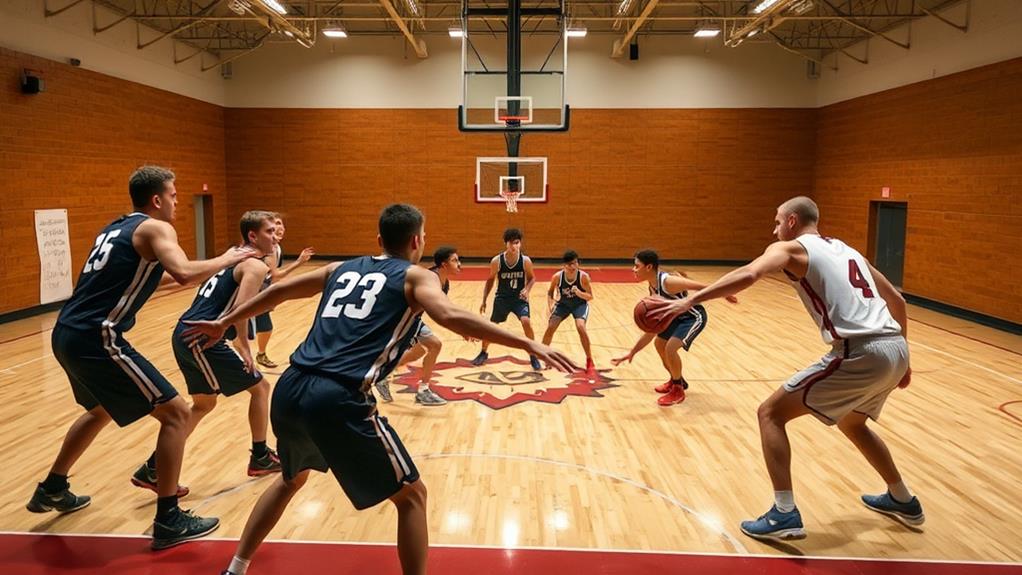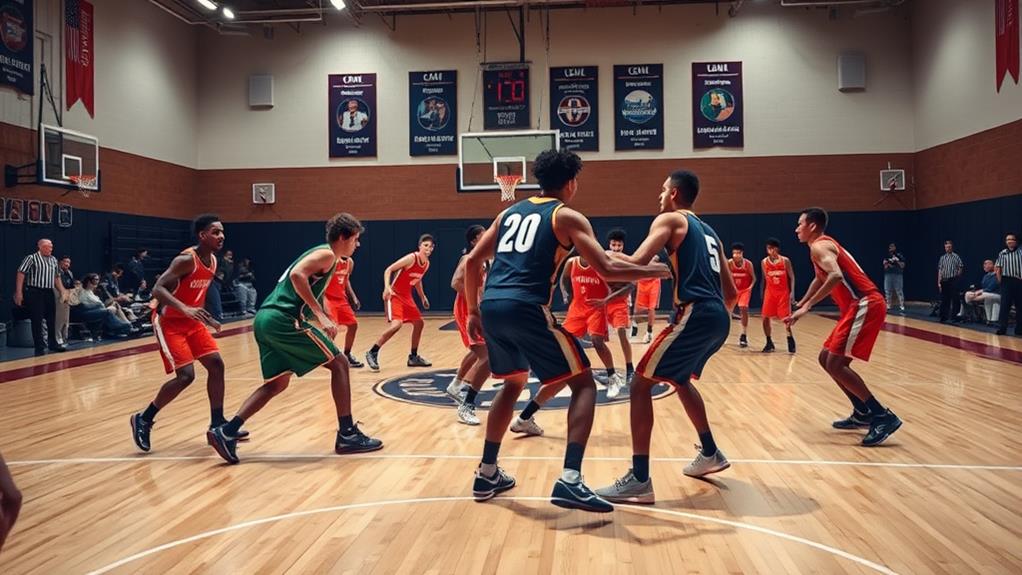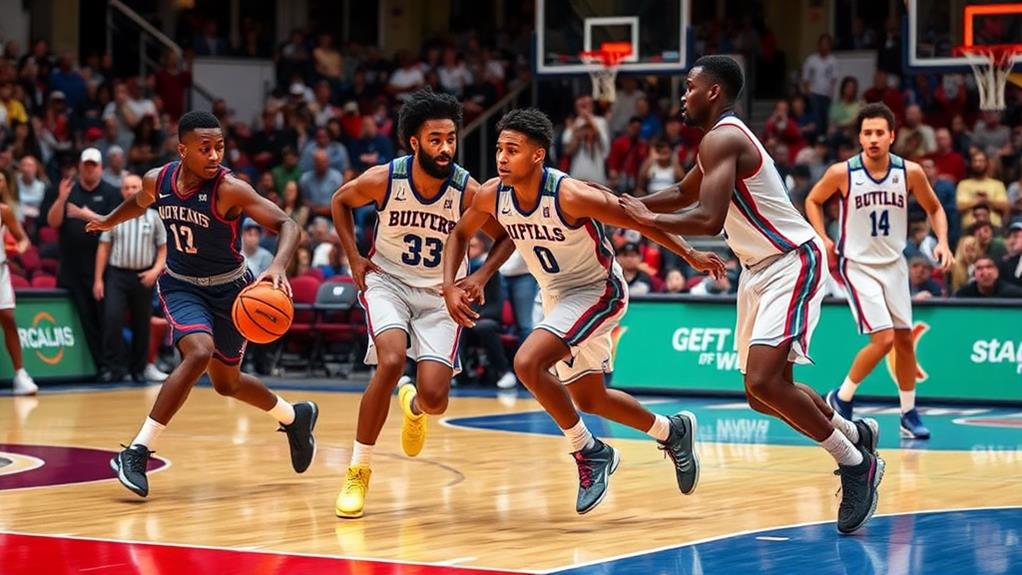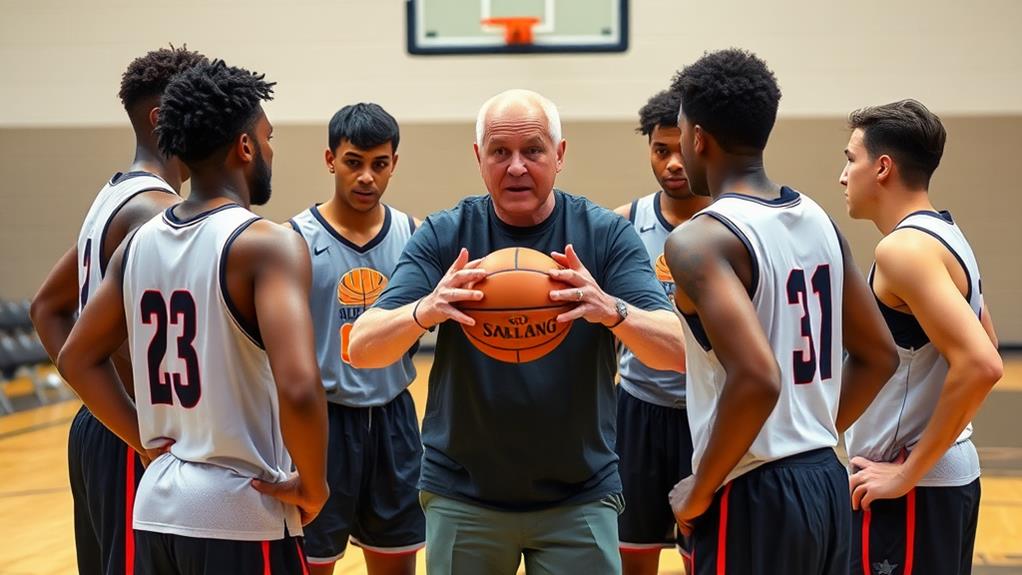
How to Run a Full-Court Press Effectively
October 4, 2024To run a full-court press effectively, focus on communication and teamwork. Decide on a strategy, like man-to-man or a zone press, that suits your players' strengths. Make sure everyone knows their roles and responsibilities. Keep the pressure on the ball handler while being ready to trap quickly. Monitor fatigue levels to maintain intensity throughout the game. Remember that defensive recovery is essential; sprint back to prevent easy baskets if your press gets broken. With the right approach, you can create turnovers and scoring opportunities. Discover more strategies to enhance your press and dominate the court.
Reasons for Implementing a Full-Court Press
Implementing a full-court press can be a game-changer, especially when you want to shake things up and gain an advantage. This strategy can create scoring opportunities by putting immense pressure on the opposing team, often leading to forced turnovers.
When you apply a full-court press, you disrupt the rhythm of the game, compelling the defensive team to make quick decisions and potentially rush their shots. Incorporating endurance training methods into your players' conditioning can enhance their ability to maintain high-intensity pressure throughout the game.
It's particularly effective against teams with poor decision-making skills; you can exploit their weaknesses and induce mistakes under pressure. By forcing the opposing team into uncomfortable situations, you not only increase your chances of steals but also dictate the tempo of the game. This can be advantageous when facing strong half-court offenses that thrive on a slower pace.
Additionally, a full-court press can rejuvenate your own team's energy during sluggish performances. The high-intensity defense engages players and often shifts momentum in your favor.
Fundamentally, the full-court press is more than just a defensive tactic; it's a dynamic strategy that can transform the flow of the game and elevate your chances of victory.
Types of Full-Court Press Strategies
When you implement a full-court press, you can choose from several effective strategies.
The Man-to-Man Press focuses on tight individual defense, which can be particularly advantageous if players are well-versed in smart defensive tactics to disrupt offensive flow.
Zone Press Variations allow you to adapt based on your opponent's weaknesses, effectively exploiting them for better scoring opportunities.
Additionally, the Run and Jump Defense adds an element of surprise, making it tough for the offense to maintain their rhythm.
Man-to-Man Press Strategy
A man-to-man press strategy is a dynamic approach that puts intense pressure on the opposing team by assigning a specific defender to each player. In a full-court man-to-man press, you'll closely mark your assignment, ensuring that your defensive player is always in position to disrupt the opponent's rhythm. This aggressive defending aims to force turnovers by creating chaos and rushing decision-making.
Effective communication is essential in this strategy. You and your teammates need to coordinate traps and cover passing lanes to prevent easy ball movement. By talking on the court, you can alert each other to switches or potential traps, which can be game-changers. This approach works especially well against teams with weak decision-making skills, as it often leads to rushed shots and increased turnover rates.
To maximize the effectiveness of a man-to-man press, coaches should regularly drill players on maintaining proper positioning and awareness. This practice will help you capitalize on trapping opportunities while executing the press.
Zone Press Variations
While a man-to-man press strategy can effectively apply pressure, exploring zone press variations can provide your team with additional defensive options.
These variations allow you to adapt your game plan based on your team's strengths and weaknesses, as well as those of your opponent.
Here are a few effective zone press formations to take into account:
- 2-2-1 Press: Two players near the free-throw line, two at half-court, and one safety, balancing pressure and coverage.
- 1-2-1-1 Press: One player pressures the ball handler, two provide support at the free-throw line, one is above the three-point line, and one back as safety.
- 1-3-1 Press: One defender at the three-point line, three across half-court, and one safety, creating a dynamic and confusing defense.
- Trapping Opportunities: Utilize aggressive double-teams in specific zones, maximizing scoring opportunities for your team.
- Effective Communication: Ascertain players are in sync to maintain pressure and prevent easy scoring opportunities for the opposing team.
Run and Jump Defense
The Run and Jump Defense is an aggressive full-court press strategy that emphasizes quick shifts from man-to-man defense to trapping the ball handler. As you implement this defense tactic, start by applying strong pressure on your assigned opponent.
When the ball handler receives the ball, communicate with your teammates and switch roles to create a trap. This change is essential for maintaining control of the ball and increasing the chances of forcing turnovers.
Positioning is key. Make certain you're covering passing lanes to limit quick ball movement and prevent easy escapes. By strategically timing your traps, you can catch opponents off guard, often using the sideline as an additional defender to restrict the ball handler's options.
For young athletes, mastering the Run and Jump Defense can greatly disrupt the offensive rhythm, leading to rushed decisions from the opposing team.
When executed well, this strategy not only creates turnovers but also opens up high-percentage scoring points for your team. Embrace this dynamic approach, and watch how it transforms your defensive game on the court.
Key Considerations for Effective Press

Success in implementing a full-court press hinges on understanding your team's strengths and weaknesses. This knowledge allows you to exert full control over your defensive strategy, aligning it with your players' capabilities and exploiting your opponent's vulnerabilities.
Additionally, leveraging data analytics can provide insights into ideal player positioning and effectiveness during the press. Here are some key considerations for guaranteeing effective press:
- Effective Communication: Make certain players know their roles and responsibilities. Clear communication reduces defensive breakdowns.
- Monitoring Player Fatigue: Keep an eye on your players' stamina. Adjust the intensity of the press to prevent exhaustion and maintain effectiveness.
- Smart Passes: Encourage players to make quick, smart passes during shifts to keep the pressure on the opposing team.
- Practicing Different Press Strategies: Vary your techniques in practice to adapt to various game situations, enhancing your team's versatility.
- Balanced Practice Time: Allocate time wisely between teaching press strategies and developing fundamental skills to guarantee thorough player development.
Challenges of Full-Court Pressing
Running a full-court press is physically demanding, and you need to be mindful of your players' stamina to avoid fatigue.
Incorporating effective conditioning techniques, such as cardio and endurance training, can help your players maintain their energy levels throughout the game.
If your team overcommits, you could leave yourself vulnerable to fast breaks, giving your opponents easy scoring chances.
Balancing the intensity of the press while maintaining defensive integrity is essential for success.
Physical Demands on Players
Employing a full-court press demands immense physical effort from players, as they're constantly sprinting and making quick directional changes to maintain defensive pressure. This high-energy style can quickly lead to fatigue, especially if your team lacks depth. Starters may find themselves playing extended minutes, which can take a toll on their stamina and conditioning.
To give you a clearer picture of the physical demands, consider the following:
- Constant Sprinting: You're always on the move, which requires explosive bursts of energy.
- Quick Directional Changes: This can lead to increased risk of injury, as rapid pivots can strain muscles.
- Continuous Pressure: Maintaining an aggressive stance means you're exerting yourself throughout the entire game.
- Fatigue Management: Monitoring your energy levels is essential; exhaustion can diminish your effectiveness.
- Injury Risk: The physicality of the press can lead to overuse injuries if you aren't careful.
Coaches must adjust the intensity based on game context and player fatigue. Remember, effective pressing hinges on balancing aggression with your players' physical readiness.
Vulnerability to Fast Breaks
One major challenge of a full-court press is its vulnerability to fast breaks, which can leave your team exposed if the press gets broken. When your defensive players are heavily engaged in pressing, they often become overcommitted, creating gaps that skilled opponents can exploit.
If they manage to break the press, you risk giving them easy scoring opportunities, especially if they've players who excel in progression. The effectiveness of a fast break increases when your opponents quickly capitalize on your defensive vulnerabilities.
Additionally, fatigue can set in among players executing the full-court press, leading to slower recovery times and further exposing your team to fast break situations.
To mitigate this risk, effective communication becomes essential. You must implement quick recovery strategies so that your defenders are prepared to sprint back into position as soon as the press is broken.
Importance of Defensive Recovery

Importance of Defensive Recovery
Recognizing the importance of defensive recovery is essential right after executing a full-court press. After putting pressure on the opposing team, you'll need to sprint back to prevent easy scoring opportunities. Remember, successful presses yield turnovers less than 25% of the time, so being prepared for a quick shift is critical.
A strong recovery allows your team to maintain compactness and organization, limiting the opponent's space and passing options.
- Always communicate with teammates about assignments and positioning.
- Implement smart rotations to cover for each other effectively.
- Confirm everyone understands their defensive responsibilities during this shift.
- Stay committed to preventing open shots; every player counts.
- A strong recovery can minimize high-percentage scoring chances for the opponent.
When players fully commit to defensive recovery, they maintain the integrity of your defensive strategy. This commitment not only prevents high-scoring opportunities but also reinforces the pressure applied during the press.
By focusing on communication and smart rotations, you can turn a potentially vulnerable moment into a chance to regain control. If players don't recover effectively, you risk giving the opponent easy baskets, undermining the effort put into the full-court press.
Prioritize defensive recovery to enhance your overall defensive effectiveness.
Designing a Press Break Offense
When facing a full-court press, designing an effective press break offense is essential for maintaining possession and advancing the ball. The urgency created by the shot clock necessitates swift execution, making it critical to practice quick decision-making under pressure.
Start by designating a reliable player as the inbounder. This player will execute quick passes to initiate the press break. Assign specific roles to your teammates, ensuring one player positions themselves in the middle of the court. This player will be significant for providing options against traps and facilitating ball movement.
Efficient ball movement is key to maximizing scoring opportunities when facing defensive pressure.
Encourage your players to spread out, utilizing deep positions to exploit the defense and create open passing lanes. This maximizes your chances for advancement.
Practicing lob passes is essential, as they can effectively bypass defenders during a press situation, allowing for smoother shifts.
Effective Inbounding Techniques

Effective inbounding techniques can make a significant difference in countering a full-court press. When executed correctly, these strategies allow your offensive team to shift quickly and effectively.
Understanding the importance of team composition can also enhance your inbounding strategies, as players need to be aware of their roles on the court.
Here are some key points to remember:
- Retrieve the ball immediately after a score and position yourself strategically between the basket and the corner.
- Direct inbound passes to your best passer, enabling them to advance the ball past half court within the 10-second limit.
- Minimize dribbling; focus on quick passing to maintain ball movement and avoid defenders.
- Start moving as soon as the ball is ready to be inbounded, creating immediate options and keeping the defense guessing.
- Use effective communication among players to guarantee everyone knows their roles and timing.
Conclusion
To sum up, mastering a full-court press can transform your team's defensive game. As the saying goes, "The best defense is a good offense." By implementing the right strategies and maintaining strong communication, you can create pressure that leads to turnovers and fast breaks. Remember, it's not just about the press itself, but also how quickly your team recovers and adapts. So, get out there, fine-tune your techniques, and watch your squad thrive on the court!


